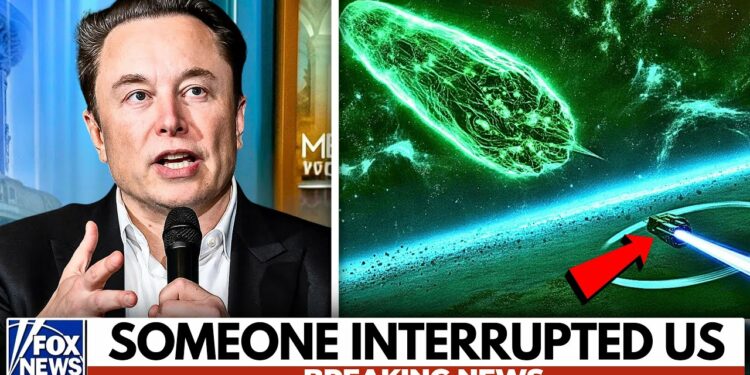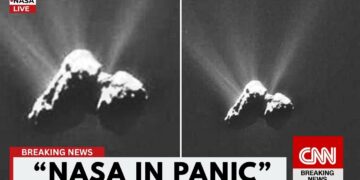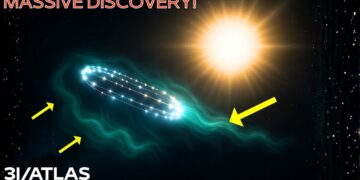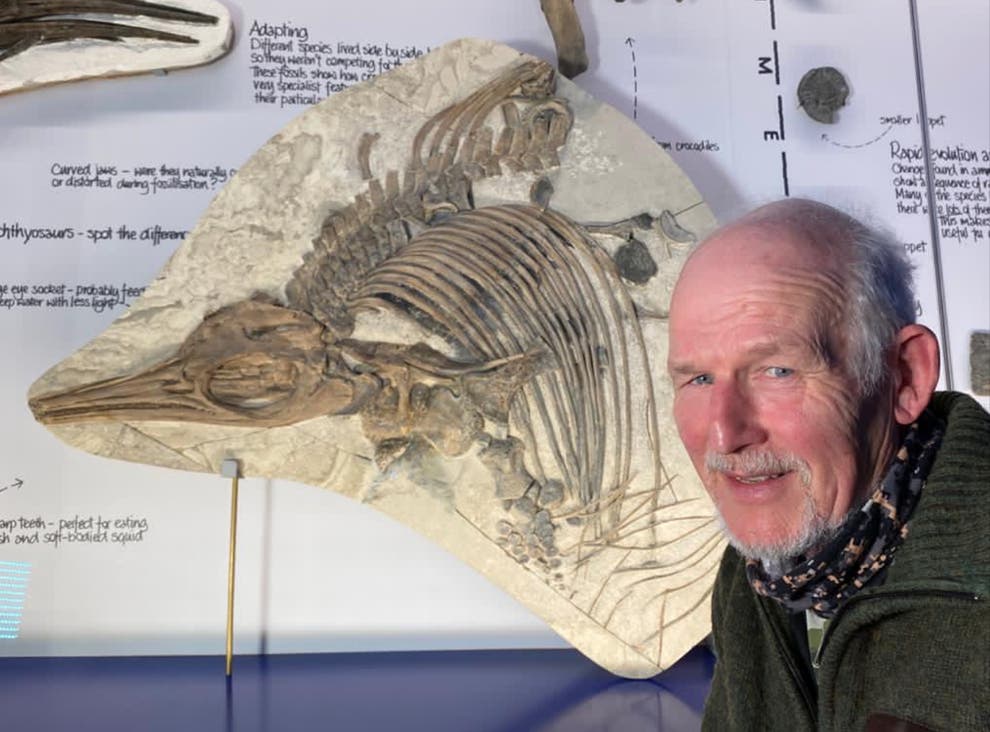It wasn’t just one thing, you know? It was like a whole bunch of things happened in a row. But now, imagine this: if there are a lot of aliens out there, well, an invasion ship—or rather, an object from another star system—just entered our solar neighborhood. Elon Musk launched a secret Falcon 9 mission to intercept it. No press, no stream, just a classified payload chasing something we’ve never touched before. What happened next stunned scientists, triggered defense protocols, and raised questions no one expected.
Discovery and Alert: The Call to Action
On July 1st, 2025, the Atlas survey station in Chile captured something strange in the sky: a hyperbolic object moving faster than any typical comet had entered our solar system. Its path made one thing clear—this was not a native body. NASA’s official confirmation soon followed. The object, named 3I/ATLAS, was moving so quickly and steeply that it couldn’t possibly originate from our solar neighborhood. It was the third interstellar object ever observed, following ‘Oumuamua and 2I/Borisov.
Within hours, SpaceX systems flagged it—not because of a collision threat to Earth, but because of what it was: a cosmic messenger, older than Earth, possibly made from materials that don’t exist here. Elon Musk, already deep in Starship testing, received an internal report from SpaceX’s orbital analytics team. The words were simple: unprecedented speed, CO2-rich, retrograde path. Interstellar objects are the only samples we get of other solar systems unless we go there ourselves, Musk later told insiders.
That’s when a conversation began quietly behind closed doors about intercepting this visitor—not just observing or photographing it, but actively sending something after it. Telescopes revealed clues about its makeup: frozen gases, water, ice, and complex organics. The real allure was scientific—this was a time capsule from somewhere far beyond our star, something that had drifted for millions of years, maybe longer. Every astronomer knew this was a once-in-a-lifetime opportunity.
NASA, ESA, and other space agencies started planning observation campaigns. But inside SpaceX, the tone was different. “We’re not waiting for it to pass us by,” someone said. “We’re going to chase it.” The urgency wasn’t about danger but about possibility. The closer 3I/ATLAS got to the sun, the more active it became—its tail lengthened, its coma glowed, it was waking up. And that meant one thing: the window for close interaction was shrinking.
Behind the scenes, Musk gave the green light to explore mission feasibility—not for a massive crude craft, but a microprobe, something small, fast, and expendable, something they could strap onto a Falcon 9 and launch before the end of the summer. “Let’s stop being observers,” Musk reportedly said, “and become participants in the interstellar age.”
Mission Planning: Can We Actually Catch It?
The excitement didn’t last long before the hard math kicked in. SpaceX teams ran the numbers, and they weren’t easy to look at. 3I/ATLAS was traveling over 130,000 mph, with an intercept window measured in weeks, not months. Rockets like Falcon 9 weren’t built for chasing interstellar bullets. And yet, the team pressed forward. “We’re not aiming to land,” explained one propulsion engineer. “We’re aiming to meet.”
The question wasn’t just whether they could reach it, but how. Early designs considered gravitational assists, like a slingshot past Mars to pick up speed, but that added time, and time was running out. So, they explored lighter payloads: microprobes, tracking beacons, or dust collectors. Even if they didn’t catch the core, brushing through the coma—the tail of gas and dust—could yield a jackpot of alien material.
There was also quiet talk of experimental tech. Elon had previously hinted at directed energy systems, laser propulsion, and high-speed comms arrays that never saw the light of day. Could this be a secret test flight under the guise of science? Risk factors were mounting—a rushed mission meant trajectory misalignment was a real danger. If they missed, there’d be nothing to show but a few burned-up probes and public criticism. But Musk was reportedly unfazed. “If it works, we’re the first species to reach across the stars,” he said. “If it fails, we tried.”
Behind the walls of Hawthorne, simulations ran day and night. Engineers adjusted launch times by seconds. Analysts calculated fuel margins down to decimal points. The final plan didn’t aim to catch the comet—it aimed to intercept a region of space where the comet would be, like firing a dart into a hurricane. By early August, the final decision was made: a Falcon 9 launch would carry a secret payload aimed at meeting 3I/ATLAS just days before its perihelion. “The math’s ugly,” one mission planner said, “but the science is beautiful.”
The Falcon 9 Launch: Real or Rumored?
By mid-August, strange activity caught the attention of the spaceflight community. A Falcon 9 manifest went dark—no listed payload, no live stream, no scheduled press release. It was a classified launch, or at least that’s what SpaceX claimed. But rumors swirled. Amateur trackers noticed the trajectory was headed toward deep space, not low Earth orbit, and it didn’t match any known satellite path. Whispers began spreading: Was this the intercept attempt?
Elon Musk didn’t confirm anything publicly, but sources close to the launch team suggested the payload was unlike anything SpaceX had sent up before—small, fast, and built for agility, possibly a microprobe swarm or something even more experimental. The idea wasn’t to land or collide but to get close enough to scan or sample the coma of 3I/ATLAS, the glowing stream of dust and gas trailing behind it. The strategy: aim not for the nucleus but for a calculated point in space where the comet’s tail would pass. The timing had to be perfect—miss by even seconds, and the payload would fly into empty space. But hit the window, and you’d get data that could redefine interstellar science.
Some speculated the mission might carry a beacon, a tracker meant to stick close to 3I/ATLAS and send back telemetry as it hurtled past the sun. Others thought it might involve directed energy tests—experimental lasers or particle beams meant to provoke a response from the object’s surface. But none of this was confirmed. The launch came and went without fanfare. What followed, however, caught everyone’s attention.
The Physics of Interception: Can It Be Done?
Catching an interstellar object isn’t like catching a satellite or even a near-Earth asteroid. 3I/ATLAS was moving at hyperbolic escape velocity—a speed so high that it’s not just leaving the solar system, it’s never coming back. At over 130,000 mph, it’s like trying to hit a bullet with another bullet while both are fired from moving trains. The problem isn’t just speed—it’s the angle, the timing, and the fuel limits. Current rocket tech, including Falcon 9, was never designed for these kinds of chases. Even the fastest missions ever launched, like New Horizons or Parker Solar Probe, had years of planning and gravity assists. This was a scramble.
Still, SpaceX engineers believed they could make it work if the payload was small enough, the trajectory precise enough, and if they caught 3I/ATLAS before it reached perihelion—the point where it would swing closest to the sun and accelerate even more. One alternative to a full intercept was to fly through the tail, sampling the coma, collecting interstellar dust, or getting spectroscopic data from a closer angle. That mission profile was tough but possible.
The other problem: accuracy. A microprobe doesn’t have the luxury of correction burns—once launched, it’s committed. Even tiny uncertainties, like solar wind or outgassing from the comet, could shift 3I/ATLAS’s path just enough to ruin the intercept. Despite this, Musk pushed ahead. The math was punishing, the window was small, and the odds weren’t great. But the potential payoff—a physical sample from another star system—was worth the risk.
Unfolding Anomalies: What Actually Happened Out There?
Not long after the classified Falcon 9 launch, ground stations and magnetometer arrays picked up something strange. Earth’s magnetic field showed a subtle but measurable spike exactly as the payload’s trajectory crossed paths with 3I/ATLAS. It wasn’t dramatic, but it was real. Quietly, NASA’s Goddard Space Flight Center logged the anomaly. Nothing was confirmed, nothing was denied, but something had clearly interacted out there.
Then came a second twist. Astronomers using high-resolution spectrographs noticed unexpected emissions from 3I/ATLAS. The color spectrum of its tail shifted, its coma brightened, showing new chemical lines—compounds that weren’t in the original scans. Something had either hit it, grazed it, or triggered a reaction. Was it solar heating, natural outgassing, or did the probe actually make contact?
Back at SpaceX, telemetry from the Falcon 9 mission suddenly went dark. Sources claimed the signal was lost minutes after the intercept window. Some blamed radiation; others said the payload simply passed into solar glare. But there were also rumors of data being quarantined, classified, and rerouted to military channels. Speculation took off. Had the probe activated some latent process on 3I/ATLAS? Was the comet reacting like a machine, or just behaving strangely under sunlight? One aerospace insider said, “The behavior we’re seeing isn’t random. It’s rhythmic.” That comment alone sparked days of viral threads.
None of the anomalies were conclusive, but together they painted a picture that no longer looked like a typical comet flyby. The next wave of discoveries only deepened the mystery.
Scientific Fallout: Data and Discoveries
As the comet raced closer to the sun, observatories worldwide tracked its changing structure. Spectroscopic data showed a clear rise in carbon dioxide, organic molecules, and exotic isotopic ratios not commonly found in solar system comets. This confirmed it: 3I/ATLAS was not just interstellar in origin but possibly older than our own solar system. The material in its coma was profound—the ratios of hydrogen to deuterium were off, suggesting its water had formed under different stellar conditions. Some scientists said this could be the first real proof that life’s ingredients are widespread across the galaxy.
Physicists noticed something else: the trajectory of 3I/ATLAS had shifted slightly but enough to confirm non-gravitational acceleration. This could be due to regular outgassing, but the timing was eerily consistent—a pulse every 17 minutes observed in the tail’s brightness. “It’s like it’s ticking,” one researcher said, “like a clock.” Theories ranged from plausible to speculative. Maybe it was a natural comet with internal pressure cycles. Or maybe, as some quietly suggested, it was a controlled object, or at least one with intentional behavior.
By now, both NASA and ESA had prioritized their observation schedules. 3I/ATLAS wasn’t just a curiosity anymore—it had become the most studied interstellar object in history. And if the data was right, the next interstellar visitor might not be just a rock. It might be a message.
Conspiracy Theories: Secrets, Speculation, and Skeptics
As the public learned more about 3I/ATLAS and SpaceX’s potential involvement, the rumor engine ignited. It started with a few forum posts, then spread across science podcasts and viral videos. Why wasn’t NASA talking more openly? Why was the Falcon 9 mission still unconfirmed? And what exactly triggered the magnetic ripple on Earth?
The most extreme theory came from a familiar name: Avi Loeb, the Harvard astrophysicist who once suggested ‘Oumuamua might have been artificial. This time, he didn’t hold back. “3I/ATLAS behaves more like a guided object than a comet,” he said during a panel. That single sentence sent speculation through the roof.
Another theory gained traction: the intercept was actually a military test. SpaceX, after all, frequently launches payloads for the U.S. Space Force. Could this have been a planetary defense experiment? Was the probe designed to track or even influence an object from another star system? Online threads began drawing connections to ancient history, pointing out that the comet’s path, inclination, and timing seemed eerily aligned with monuments like Machu Picchu and Göbekli Tepe. Were we seeing something humanity had witnessed long ago, or was this just a coincidence wrapped in myth?
NASA, for its part, stayed cautious. “3I/ATLAS is behaving like a natural comet,” said one spokesperson. But many weren’t convinced. Internal leaks hinted at data not yet released. Even Elon Musk added fuel when he tweeted cryptically, “Sometimes the truth is just outside escape velocity.” The theories may never be proven, but they reflect something deeper: people felt this event wasn’t just scientific—it was significant.
Musk’s Outcome: Success, Failure, or Compromise?
In the days that followed, no official success was announced—no press releases, no triumphant tweets. The mission, by all public accounts, had vanished into silence. But silence doesn’t always mean failure. Sources close to SpaceX described the mission as a partial win. The microprobe may not have hit the nucleus, but it passed close enough to sample the coma, picking up particles now being analyzed in labs under non-disclosure agreements. A few grams of alien dust could still change everything.
Elon Musk remained vague. When asked directly during a tech event, he smiled and said, “Let’s just say we learned a lot.” That alone set off a new wave of speculation. Was this a soft confirmation that something extraordinary had happened?
Behind the scenes, there were consequences. Financial analysts questioned the cost of an unproven deep-space launch. Some board members reportedly pushed for more transparency, but Musk held the line. “Innovation doesn’t wait for permission,” he said privately.
For the broader science community, the mission forced a pivot. Astrophysicists and planetary defense experts began discussing how to track, tag, and maybe even redirect future interstellar objects. Whether Musk’s mission succeeded or not, it had pushed the boundaries of what was possible. And within SpaceX, plans began shifting. Next time, it wouldn’t be about chasing—it would be about getting there first.
Broader Implications: We’re Entering a New Era
After the intercept attempt, the conversation shifted. Scientists, engineers, and policymakers realized that 3I/ATLAS wasn’t just an event—it was a turning point. For the first time, we didn’t just observe an interstellar object; we engaged with one. Even a partial intercept meant something profound had changed in how humanity approaches space.
Planetary defense teams expanded their frameworks. Before this, most protocols were built around asteroids and comets from within our solar system. But 3I/ATLAS proved that interstellar threats—or opportunities—weren’t theoretical anymore. The need for faster tracking systems, better non-gravitational modeling, and new intercept technologies became a top priority.
The scientific gains were equally massive. Dust from another star system, if that’s what was gathered, could reshape our understanding of how solar systems form. Were the building blocks of life scattered universally? Could we one day trace our origins not to Earth but to an interstellar neighbor?
Meanwhile, the public response showed something else. For many, this wasn’t just a space mission—it felt like contact with something bigger, a chance to touch the unknown. People talked about it like an awakening. Ancient myths were re-examined, and cultural narratives took on new meaning. Elon Musk had once joked that space isn’t a destination—it’s a starting line. After 3I/ATLAS, it wasn’t just about Mars or the moon anymore. We had officially stepped into the interstellar age. And SpaceX wasn’t done yet.
Future Moves: What Happens Next?
According to Musk’s playbook, within weeks of the mission, SpaceX insiders confirmed that new plans were underway—not just for a one-off intercept but for a standing program, a fast-response system that could launch probes to track or sample any new interstellar object within weeks, not years. Behind closed doors, engineers began sketching a new class of interceptor vehicles—smaller, faster, equipped with modular payloads for everything from dust sampling to beacon deployment. The goal wasn’t just scientific; it was strategic. “We need the ability to respond to any visitor,” Musk told his team.
Monitoring networks would need upgrades too. Current detection relies on Earth-based surveys with limited fields of view. Musk pushed for orbital telescopes and fast-scanning, AI-powered systems that could catch faint hyperbolic objects before they slip past unnoticed.
On the policy front, international space agencies began informal talks. NASA, ESA, and even China’s CNSA agreed on one thing: next time, there should be a global response. Space is no longer passive—it’s a shared frontier. Public readiness also became a new focus. If interstellar objects can carry clues or risks from other systems, the public deserves timely, clear information. That means transparency, not secrecy. Musk hinted that next time, SpaceX might live-stream the intercept attempt, win or lose.
But perhaps the most important shift is this: from now on, every object that enters our solar system will be met with more than curiosity—it will be met with action. As Musk put it, “We’re done watching the universe go by. We’re going to meet it head-on.”
Whether SpaceX made contact or not, this moment changed space history. Elon Musk didn’t just launch a rocket—he launched humanity into the interstellar age. The evidence is mounting, and the implications are bigger than anyone imagined. Because next time an object arrives from beyond, we won’t just watch. We’ll be ready.
























